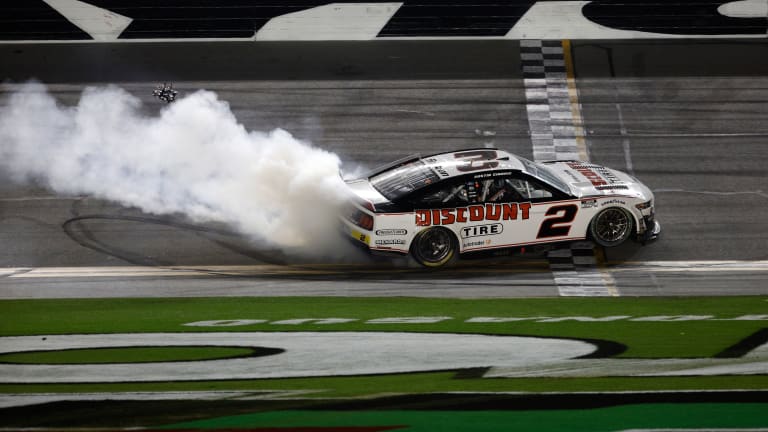
So far, so good: new Cup car off to promising start

Years ago when my aging dad’s mind was slipping but his humor wasn’t, he came home from dinner and gave us a review of the restaurant.
“I’m not sure what I just ate,” he said, “but I highly recommend it.”
I thought of that as a new era of NASCAR Cup Series racing unfolded Sunday in the Daytona 500.
To a degree, I’m not quite sure what we witnessed. The Next Gen car, with its independent suspension, single-lug wheels, and an underside flat as a Kansas highway, created a race of intrigue, if not downright fear when things went wrong.
But in the end, we got a Daytona 500 that we’re all familiar with, featuring a clear Ford vs. Chevy vs. Toyota battle and a bumper-banging, hip-checking finish that gave us a rookie winner.
Cup rookie Austin Cindric kept the nose of his Team Penske Ford clean and out front the last seven laps, including a green-white-checker restart with a push from Penske teammate Ryan Blaney.
Well done, NASCAR.
Now let’s see how the rest of this Next Gen project plays out. Super speedways are such wild-card events with pack racing and blocking and, sometimes, surprise winners. How will this car race on the intermediate and short tracks? Were the issues we saw in the 500 – disconnected hood flaps, broken wheels and a blow-over flip – one-of-a-kind flukes or something to be concerned about this season, especially on the fastest speedways?
Frankly, those things worried me.
The race wasn’t a quarter old when a wheel broke off Kaz Grala’s car. Fourteen laps later, a wheel on Justin Haley’s car broke, causing the tire to roll down the track. By the time Haley reached his pit, only the rim of the wheel remained.
Whether those were one-and-done failures or an indication of something that needs further study, the pucker factor must have gone up in the cockpits. I know it did from where I sat.
And that was before Harrison Burton took flight in his No. 21 Wood Brothers car when a push out of Turn 2 from Brad Keselowski went bad as racers jockeyed for position near the end of Stage 1. Burton’s car began to loop and, with the back of the car swapping with the front, it blew over onto its top, then back onto its wheels. Burton wasn’t hurt, but the car was a mess, and the ensuing concern was whether the design of the flat undertray of the Next Gen car caused it to lift.
With so much that is new with these cars, the Daytona 500 not only was their biggest high-speed test but also an event with the highest stakes and tremendous risk. How can you not respect these drivers for racing flat-out amid factors that aren’t completely known?
The race actually settled down after the Burton crash. Fords fell into line on the high side, Toyotas and Chevrolets down low, and there wasn’t the three-wide racing we’d become familiar with in past.
But you knew it was coming. Because this is Daytona, whether or not you like this kind of racing.
The pushing and blocking led to two crashes, one causing a red flag, inside the final 11 laps to set up a green-white-checker restart. The Penske cars of Cindric and Blaney were 1-2, but Keselowski and Bubba Wallace were in perfect position to spoil the Penske party if they made just the right moves in the final two laps.
How high was the tension?
On the FOX telecast, Clint Bowyer asked Tony Stewart a great question to get the perspective of a former driver: “Where do you want to be Tony?”
Stewart’s answer: “Right up here with you!”
The Penske drivers played perfect teammates, with Blaney pushing Cindric until the final charge out of Turn 4. Blaney moved high and Cindric blocked high. Wallace moved low but Cindric pinched him off to win by less than a car length.
It became a classic Daytona 500 finish in an era for NASCAR that creates a lot of intrigue for what the rest of the season will bring.
I must admit, I’m not totally sure what I watched with this new car. But I highly recommend it.